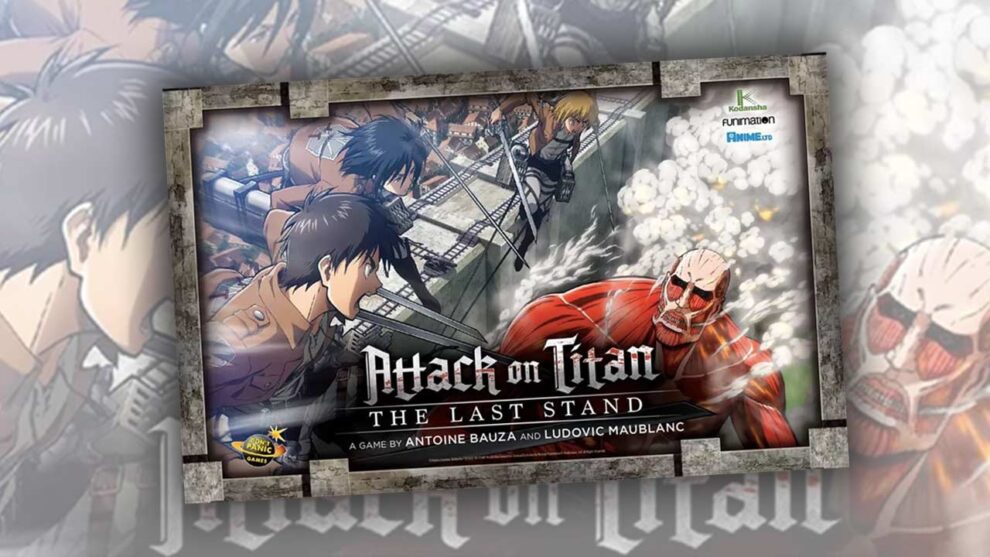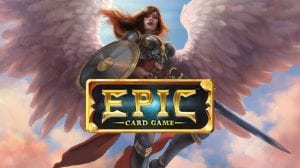Disclosure: Meeple Mountain received a free copy of this product in exchange for an honest, unbiased review. This review is not intended to be an endorsement.
As I write these reviews, I typically try to discuss how the game’s theme or history resonates with me personally. However, I have limited experience with the Attack on Titan franchise, having only watched the first season of the anime. While I was enthralled by the stunning animation and epic opening theme song, which I listened to frequently for months, the writing itself failed to draw me in. By the end of the first season, my response to any further discussions of the show was the world’s loudest shrug.
However, I can’t deny that a bunch of gals and guys slicing up a titan does sound like good board game material, and that’s what brings me here today. Attack on Titan: The Last Stand is a lightweight 30-minute one-vs.-all, with one being the titan and the other players wearing the clothes of the heroes of the show. Like most cooperative games, these Heroes have a special ability that breaks the rules of the game. Meanwhile, the Titan player picks one out of four personalities, which serves as the game’s difficulty setting.
The Titan has three potential victory conditions: consume all citizens, demolish all cannons, or defeat a Hero. The hero players win by depleting the Titan’s health to a “kill zone” between 1-3 points and then playing a tactic card to deliver the final blow. Further highlighting the asymmetry, the Titan utilizes card-based actions, while the heroes rely on dice rolls to power their moves. This mismatch of mechanics neatly encapsulates the contrast between the towering Titan and the vulnerable yet crafty Heroes, echoing the themes of the show.

Breaching the Walls
The Titan player starts the round off by playing two cards from their hand, one face up and one face down. These cards aren’t activated right away, as they act as incoming threats to the heroes and represent the telegraphed moves of these goliath Titans. After the Titan is done finalizing their choices, the Heroes start by rolling the dice. Each face of the die represents a different action, and the Heroes can reroll as many times as they like. The important drawback here is that any Titan heads they roll must be given to the Titan player, who can then spend them to do various actions like eat a citizen, heal, or damage a hero.
Now I have to give credit here because, in this part of the game, there are no turns. Heroes are free to reroll as many times as they like and openly discuss their feelings towards the situation. None of this “take your turns clockwise” nonsense that we are used to experiencing. I wish more cooperative games allowed this type of freedom, and I highly recommend any future designers steal this system. Anyway, back to explaining the game.
Once the Heroes are satisfied with their die results, the Titan player spends their Titan heads on the actions, and the cards are resolved, starting with the revealed card and then the unrevealed card. These cards can be framed in two categories: events and attacks.
Events are simply bad effects, such as eating a citizen while smashing a cannon or forcing the tactic cards to be reshuffled. The only defense against these cards is the tactics die result that the Heroes must spend to stop the card from activating. The attack cards are a bit different in that they target particular levels, and any Hero caught in those levels must spend two dodge die results to prevent the effect.

Entrapped by Titans
The game uses a vertical-level system to illustrate the drastic size difference between the Heroes and the colossal Titan. There are 8 levels in total, with level 0 representing the ground and level 8 nearing the Titan’s head. Importantly, levels 3 and 5 correspond to structures on which the heroes can stand to fire cannons and inflict extra damage against the titan. This clever use of levels captures the sense of scale while integrating it directly into the gameplay mechanics. The Heroes must strategically utilize these elevated vantage points to gain any hope of taking down their massive foe. However, this cannot be too predictable because the Titan can also attack at those points as well.
Once the Titan’s card effects are resolved, the Heroes can utilize their dice results as desired: moving around, attacking the titan, firing cannons, etc. One key element is the tactics cards. These represent public objectives that provide special effects or conditions if the Heroes complete them. To gain the benefit of a tactics card, Heroes must meet the card’s requirements by being on a particular level and spending specific die results. So the tactics cards give the Heroes strategic incentives and advantages for coordinating and carrying out certain maneuvers against their massive foe.
While I did spend quite a few paragraphs going through a round of a game, it’s not a hard game to process. I would even dare label this an entry-level game since it borrows familiar elements from many other games, like Yahtzee and King of Tokyo. It’s not a challenging game to teach, and unfortunately, that’s one of the few positives about this one.

Blades Too Dull
There are numerous issues with Attack on Titan: The Last Stand, and to start things off, let’s talk about the role of the Titan player. Simply put, you aren’t doing much, and you feel more like a facilitator than a game player. You pick two cards from your hand, with one of them facing down. At most, you are playing a psychological contest with your opponents since they have to debate whether or not your facedown card will require them to use escape or tactics dice to prevent the pain. It’s an amusing idea that should be playing a bigger role, but it doesn’t. Another area of concern is the Titan head die results. Unless the Heroes are taking risks or are unlucky, a Titan player’s involvement in the game can start and end with the Titan cards.
The game’s design clearly prioritizes the Heroes’ experience. The Heroes are the ones rolling dice, taking risks, and making compelling decisions each turn. They must contend with limitations, like needing to be on certain levels to utilize cannons or tactics cards. Their primary concern is the looming titan cards, requiring them to weigh risk versus reward when deciding whether to reroll the dice for that 1-in-6 shot at a Titan head. The heroes must collaborate and problem-solve to overcome the challenges they face.
At least that should be the case if the Hero powers didn’t neuter the challenges this game offers. You don’t want to be at specific levels to use cannons? There’s a character power for that. You don’t want to go through your tactics deck? A power does exist where you can pick whatever tactic card you like. There is even a power where you don’t give any Titan head die results to the Titan player. What is the point of creating these obstacles for the Heroes to overcome when they can simply ignore them? It’s like watching a sprinter argue that cutting off their legs would make them faster.
There is also one particular tactic card that shouldn’t exist. If the Hero pulls it off, the Titan player has to play their two Titan cards face-up for the rest of the game. Forget the Titan player being a facilitator at this point, they are just spectators now. I guess the reasoning behind this tactic card is that the Titan player has something to fear, but I’m sure it could’ve been a much better way to instill the concern without going this extreme.

Colossal Let Down
What’s absolutely confusing to me, though, is that this is a game released in 2016 and reprinted in 2023 by Japanime Games. Despite 7 years of feedback and mixed reviews, nothing changed. The game is extremely swingy with a lack of difficulty arc due to the dice rolls, and the game is clearly not balanced. Even the components didn’t change, which would’ve been the first thing I would’ve done since setting up that cannon tower is a knife fight against gravity since it barely holds up.
The core concept here—one player controlling obstacles while a team navigates through risk management and dice rolls—has potential. The asymmetric, adversarial gameplay could create an engaging experience. Unfortunately, the execution falls short here. Despite the promising framework, the questionable Hero’s powers and the Titan player’s lack of engaging decisions fail to create a compelling experience.
While the Attack on Titan theme offers an epic backdrop, the mechanics fail to evoke the tense battles and calculated maneuvers that define the franchise. With more care taken to hone the adversarial gameplay and create meaningful interplay between the two sides, this could have been an enjoyable encapsulation of Attack on Titan. As is, the frame cannot support the faulty interior.












Great anime. Great review.
Sounds like the game came up wanting. 🙁